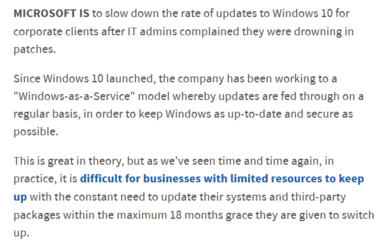And also it depends in which order the system tries to install the updates. So first Windows 7 finds an Internet Explorer 7 and downloads updates for this (at least the cumulative update) and also downloads the IE 11. So if first is IE 11 installed the patch for IE 7 couldn't be applied. After the next boot you will see the error, but the system should not try to install this patch again.
I have created cmd scripts and an virtual machine setup to update a wim file automatically. Currently it is just updating one image in a wim file but I will change this.
For short, the complete system will do this:
Prepare a virtual hard disk to use a windows setup (make a backup of boot.wim and an epxort of the given image of the install.wim, ie. index 4).
Mouint the new install.wim and inject some updates (some of the updates from page 1), also updates for Internet Explorer 11 and the Intel USB 3 driver.
Unmount the wim file and the hard disk.
Use this VHD to start an automated setup process using an autounattend.xml on a virtual floppy disk.
Start the VM from the second vhd once initiaing the installation process.
During installation some scripts run for configuring auto logon and some other things.
After the setup is done the installed Wiindows is started and a user is logged on.
Than the setup process runs through the script, looking for updates, wait until they have found, download and install maximum 50 updates. Backup the installed updates on the second hard disk and write a log file. Then reboot and start over.
If no updates have been installed clean a little bit up the system - which is not necessary any more and shut down.
If the VM is down the main script outdsite mounts the second hard disk, copy the install.wim used for the installation, the log file and the backup of the installed patches.
Then the script unmounts the VHD and mounts the install.wim file, injecting the successfull installed updates.
At the end the install.wim will be unomunted.
So I get an install.wim with only 1 image, but up to date.
Using
dism /export-image
I can put the pieces together to get one complete install.wim again, which is not automated yet.
If I get the scripts finished I try to post it here.
I have created cmd scripts and an virtual machine setup to update a wim file automatically. Currently it is just updating one image in a wim file but I will change this.
For short, the complete system will do this:
Prepare a virtual hard disk to use a windows setup (make a backup of boot.wim and an epxort of the given image of the install.wim, ie. index 4).
Mouint the new install.wim and inject some updates (some of the updates from page 1), also updates for Internet Explorer 11 and the Intel USB 3 driver.
Unmount the wim file and the hard disk.
Use this VHD to start an automated setup process using an autounattend.xml on a virtual floppy disk.
Start the VM from the second vhd once initiaing the installation process.
During installation some scripts run for configuring auto logon and some other things.
After the setup is done the installed Wiindows is started and a user is logged on.
Than the setup process runs through the script, looking for updates, wait until they have found, download and install maximum 50 updates. Backup the installed updates on the second hard disk and write a log file. Then reboot and start over.
If no updates have been installed clean a little bit up the system - which is not necessary any more and shut down.
If the VM is down the main script outdsite mounts the second hard disk, copy the install.wim used for the installation, the log file and the backup of the installed patches.
Then the script unmounts the VHD and mounts the install.wim file, injecting the successfull installed updates.
At the end the install.wim will be unomunted.
So I get an install.wim with only 1 image, but up to date.
Using
dism /export-image
I can put the pieces together to get one complete install.wim again, which is not automated yet.
If I get the scripts finished I try to post it here.

